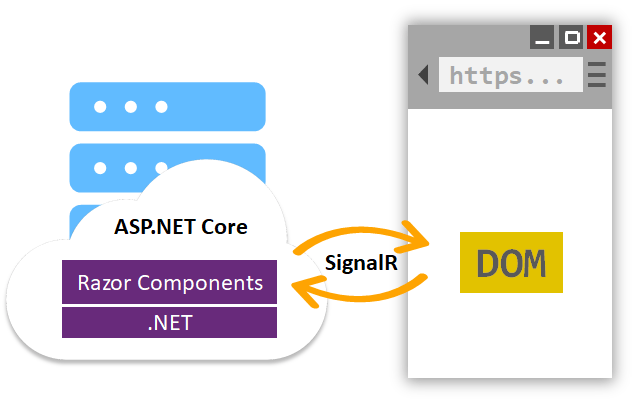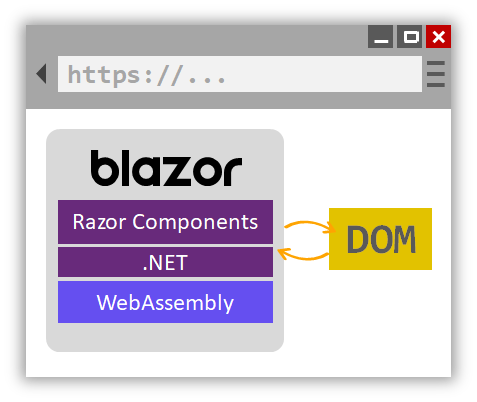ASP.NET Core Blazor
Note
This isn't the latest version of this article. For the current release, see the .NET 8 version of this article.
Warning
This version of ASP.NET Core is no longer supported. For more information, see .NET and .NET Core Support Policy. For the current release, see the .NET 8 version of this article.
Important
This information relates to a pre-release product that may be substantially modified before it's commercially released. Microsoft makes no warranties, express or implied, with respect to the information provided here.
For the current release, see the .NET 8 version of this article.
Welcome to Blazor!
Blazor is a .NET frontend web framework that supports both server-side rendering and client interactivity in a single programming model:
Blazor is a framework for building interactive client-side web UI with .NET:
- Create rich interactive UIs using C#.
- Share server-side and client-side app logic written in .NET.
- Render the UI as HTML and CSS for wide browser support, including mobile browsers.
- Build hybrid desktop and mobile apps with .NET and Blazor.
- Create rich interactive UIs using C#.
- Share server-side and client-side app logic written in .NET.
- Render the UI as HTML and CSS for wide browser support, including mobile browsers.
Using .NET for client-side web development offers the following advantages:
- Write code in C#, which can improve productivity in app development and maintenance.
- Leverage the existing .NET ecosystem of .NET libraries.
- Benefit from .NET's performance, reliability, and security.
- Stay productive on Windows, Linux, or macOS with a development environment, such as Visual Studio or Visual Studio Code. Integrate with modern hosting platforms, such as Docker.
- Build on a common set of languages, frameworks, and tools that are stable, feature-rich, and easy to use.
Note
For a Blazor quick start tutorial, see Build your first Blazor app.
Components
Blazor apps are based on components. A component in Blazor is an element of UI, such as a page, dialog, or data entry form.
Components are .NET C# classes built into .NET assemblies that:
- Define flexible UI rendering logic.
- Handle user events.
- Can be nested and reused.
- Can be shared and distributed as Razor class libraries or NuGet packages.
The component class is usually written in the form of a Razor markup page with a .razor file extension. Components in Blazor are formally referred to as Razor components, informally as Blazor components. Razor is a syntax for combining HTML markup with C# code designed for developer productivity. Razor allows you to switch between HTML markup and C# in the same file with IntelliSense programming support in Visual Studio.
Blazor uses natural HTML tags for UI composition. The following Razor markup demonstrates a component that increments a counter when the user selects a button.
<PageTitle>Counter</PageTitle>
<h1>Counter</h1>
<p role="status">Current count: @currentCount</p>
<button class="btn btn-primary" @onclick="IncrementCount">Click me</button>
@code {
private int currentCount = 0;
private void IncrementCount()
{
currentCount++;
}
}
Components render into an in-memory representation of the browser's Document Object Model (DOM) called a render tree, which is used to update the UI in a flexible and efficient way.
Build a full-stack web app with Blazor
Blazor Web Apps provide a component-based architecture with server-side rendering and full client-side interactivity in a single solution, where you can switch between server-side and client-side rendering modes and even mix them in the same page.
Blazor Web Apps can quickly deliver UI to the browser by statically rendering HTML content from the server in response to requests. The page loads fast because UI rendering is performed quickly on the server without the need to download a large JavaScript bundle. Blazor can also further improve the user experience with various progressive enhancements to server rendering, such as enhanced navigation with form posts and streaming rendering of asynchronously-generated content.
Blazor supports interactive server-side rendering (interactive SSR), where UI interactions are handled from the server over a real-time connection with the browser. Interactive SSR enables a rich user experience like one would expect from a client app but without the need to create API endpoints to access server resources. Page content for interactive pages is prerendered, where content on the server is initially generated and sent to the client without enabling event handlers for rendered controls. The server outputs the HTML UI of the page as soon as possible in response to the initial request, which makes the app feel more responsive to users.
Blazor Web Apps support interactivity with client-side rendering (CSR) that relies on a .NET runtime built with WebAssembly that you can download with your app. When running Blazor on WebAssembly, your .NET code can access the full functionality of the browser and interop with JavaScript. Your .NET code runs in the browser's security sandbox with the protections that the sandbox provides against malicious actions on the client machine.
Blazor apps can entirely target running on WebAssembly in the browser without the involvement of a server. For a standalone Blazor WebAssembly app, assets are deployed as static files to a web server or service capable of serving static content to clients. Once downloaded, standalone Blazor WebAssembly apps can be cached and executed offline as a Progressive Web App (PWA).
Build a native client app with Blazor Hybrid
Blazor Hybrid enables using Razor components in a native client app with a blend of native and web technologies for web, mobile, and desktop platforms. Code runs natively in the .NET process and renders web UI to an embedded Web View control using a local interop channel. WebAssembly isn't used in Hybrid apps. Hybrid apps are built with .NET Multi-platform App UI (.NET MAUI), which is a cross-platform framework for creating native mobile and desktop apps with C# and XAML.
The Blazor Hybrid supports Windows Presentation Foundation (WPF) and Windows Forms to transition apps from earlier technology to .NET MAUI.
Blazor Server
Blazor Server provides support for hosting Razor components on the server in an ASP.NET Core app. UI updates are handled over a SignalR connection.
The runtime stays on the server and handles:
- Executing the app's C# code.
- Sending UI events from the browser to the server.
- Applying UI updates to a rendered component that are sent back by the server.
The connection used by Blazor Server to communicate with the browser is also used to handle JavaScript interop calls.

Blazor Server apps render content differently than traditional models for rendering UI in ASP.NET Core apps using Razor views or Razor Pages. Both models use the Razor language to describe HTML content for rendering, but they significantly differ in how markup is rendered.
When a Razor Page or view is rendered, every line of Razor code emits HTML in text form. After rendering, the server disposes of the page or view instance, including any state that was produced. When another request for the page occurs, the entire page is rerendered to HTML again and sent to the client.
Blazor Server produces a graph of components to display similar to an HTML or XML DOM. The component graph includes state held in properties and fields. Blazor evaluates the component graph to produce a binary representation of the markup, which is sent to the client for rendering. After the connection is made between the client and the server, the component's static prerendered elements are replaced with interactive elements. Prerendering content on the server in order to load HTML content on the client quickly makes the app feel more responsive to the client.
After the components are interactive on the client, UI updates are triggered by user interaction and app events. When an update occurs, the component graph is rerendered, and a UI diff (difference) is calculated. This diff is the smallest set of DOM edits required to update the UI on the client. The diff is sent to the client in a binary format and applied by the browser.
A component is disposed after the user navigates away from the component.
Blazor WebAssembly
Blazor WebAssembly is a single-page app (SPA) framework for building interactive client-side web apps with .NET.
Running .NET code inside web browsers is made possible by WebAssembly (abbreviated wasm). WebAssembly is a compact bytecode format optimized for fast download and maximum execution speed. WebAssembly is an open web standard and supported in web browsers without plugins. WebAssembly works in all modern web browsers, including mobile browsers.
WebAssembly code can access the full functionality of the browser via JavaScript, called JavaScript interoperability, often shortened to JavaScript interop or JS interop. .NET code executed via WebAssembly in the browser runs in the browser's JavaScript sandbox with the protections that the sandbox provides against malicious actions on the client machine.

When a Blazor WebAssembly app is built and run:
- C# code files and Razor files are compiled into .NET assemblies.
- The assemblies and the .NET runtime are downloaded to the browser.
- Blazor WebAssembly bootstraps the .NET WebAssembly runtime and configures the runtime to load the assemblies for the app. The runtime uses JavaScript interop to handle DOM manipulation and browser API calls.
The size of the published app, its payload size, is a critical performance factor for an app's usability. A large app takes a relatively long time to download to a browser, which diminishes the user experience. Blazor WebAssembly optimizes payload size to reduce download times:
- Unused code is stripped out of the app when it's published by the Intermediate Language (IL) Trimmer.
- HTTP responses are compressed.
- The .NET runtime and assemblies are cached in the browser.
Blazor Hybrid
Hybrid apps use a blend of native and web technologies. A Blazor Hybrid app uses Blazor in a native client app. Razor components run natively in the .NET process and render web UI to an embedded Web View control using a local interop channel. WebAssembly isn't used in Hybrid apps. Hybrid apps encompass the following technologies:
- .NET Multi-platform App UI (.NET MAUI): A cross-platform framework for creating native mobile and desktop apps with C# and XAML.
- Windows Presentation Foundation (WPF): A UI framework that is resolution-independent and uses a vector-based rendering engine, built to take advantage of modern graphics hardware.
- Windows Forms: A UI framework that creates rich desktop client apps for Windows. The Windows Forms development platform supports a broad set of app development features, including controls, graphics, data binding, and user input.
JavaScript interop
For apps that require third-party JavaScript libraries and access to browser APIs, components interoperate with JavaScript. Components are capable of using any library or API that JavaScript is able to use. C# code can call into JavaScript code, and JavaScript code can call into C# code.
Code sharing and .NET Standard
Blazor implements the .NET Standard, which enables Blazor projects to reference libraries that conform to .NET Standard specifications. .NET Standard is a formal specification of .NET APIs that are common across .NET implementations. .NET Standard class libraries can be shared across different .NET platforms, such as Blazor, .NET Framework, .NET Core, Xamarin, Mono, and Unity.
APIs that aren't applicable inside of a web browser (for example, accessing the file system, opening a socket, and threading) throw a PlatformNotSupportedException.
